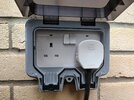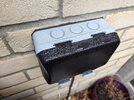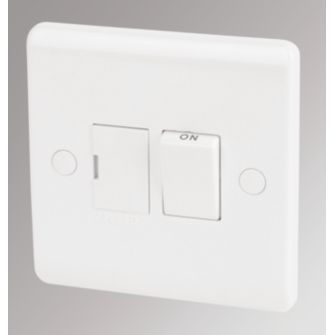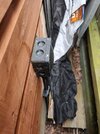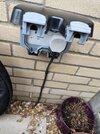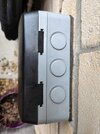I moved to the UK a few years ago so still getting familiar with the usuall switches/fuses stuff. Not sure where to look, i.e there's no GFCI outlet with a reset button right?.
I will assume from your use of them term GFCI that you are from North America.
Socket circuits in the UK can typically supply far more power than socket circuits in North America. Socket circuits in the US are 15A or 20A, while those in the UK are normally 32A but sometimes 20A, the voltage is also double, leading to the circuit being able to supply 3 times as much power. The result is we need far less circuits in the UK than in North America. Our plugs contain fuses to provide overcurrent protection for the flexible cables. 32A circuits are most commonly installed in the form of a ring, though they can also be installed as a "radial" circuit with heavier cable.
Lighting in the UK is normally on separate circuits from sockets, usually protected with a 6A breaker.
Which brings us to a device known as the FCU or sometimes "fused spur" (technically a "fused spur" is a spur fed from a FCU but people commonly use the term to refer fo the accessory itself).
FCUs as the name suggests contain a fuse, they also usually but not always have a switch. The switch is normally (perhaps always) double pole. They are used for a variety of functions including.
* Providing over-current protection for a spur that serves multiple sockets or is wired in smaller cable than is allowed for non-fused spurs.
* Allowing a spur to be switched on and off.
* Providing over-current protection and/or switching for fixed appliances.
* Providing over-current protection for lighting that is fed from a socket circuit.
You also see 20A double pole switches, which can be used for switching of spurs or fixed equipment where covercurrent protection is not needed. Some brands of these can be hard to distinguish from light switches.
Roughly speaking what americans call a GFCI we call a RCD (things are a little more complex than that but we don't need to go into it here)
We don't have a direct equivilent to the American "GFCI outlet". Sockets with built in RCDs exist but are uncommon and the RCD in them only protects that one socket, it does not have "load" terminals like American GFCI outlets do. You also sometimes see FCUs with RCD protection or standalone RCDs in their own enclosures, but again these are relatively unusual. RCD protection in the UK is normally handled in the consumer unit (roughly, what americans would call a "panel"). Sometimes a RCD is shared between multiple circuits, other times it is integrated with the overcurrent protection in the form of what we call a RCBO (roughly, what Americans would call a GFCI breaker).
The house was built only 3/4 years ago and the socket as you can see looks pretty new and sealed, but I guess is still possible it has broken in the inside?.
While not impossible, given the lack of visual deterioration and given that neither side of the double socket works I think it's relatively unlikely that the socket itself is at fault.
I would say that the most likely explanation is that the supply to the outside socket has been switched off somewhere. It's also possible that a wire has come out of a terminal.
While an outside socket can be connected directly to an indoor socket circuit this is often considered poor practice, since if the socket does end up full of water it can take out RCDs and leave a large part of the electrical installation unusable until it is sorted. It's quite common for an outside socket to be supplied from a switch or FCU.
I would certainly be taking a look around inside in the vicinity of the socket for any switches or FCUs that do not have an obvious function, which may be used to switch the outside socket. I would also check the consumer unit to see if there is a dedicated breaker for the outside socket there that may be turned off.


